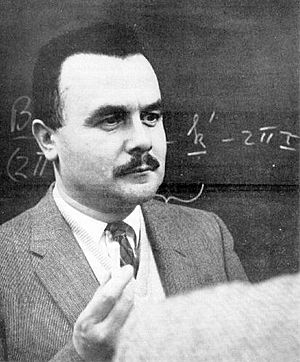Bertram Brockhouse facts for kids
Quick facts for kids
Bertram Brockhouse
|
|
|---|---|
 |
|
| Born |
Bertram Neville Brockhouse
July 15, 1918 |
| Died | October 13, 2003 (aged 85) |
| Nationality | Canadian |
| Alma mater |
|
| Awards |
|
| Scientific career | |
| Institutions | McMaster University |
| Thesis | The effect of stress and temperature upon the magnetic properties of ferromagnetic materials (1950) |
| Doctoral advisor | James Reekie |
| Doctoral students | Sow-Hsin Chen |
Bertram Neville Brockhouse (July 15, 1918 – October 13, 2003) was a famous Canadian physicist. He won the Nobel Prize in Physics in 1994. He shared this award with Clifford Shull. They were honored for their important work in studying materials using a method called neutron scattering.
Contents
Early Life and Learning Journey
Bertram Brockhouse was born in Lethbridge, Alberta, Canada. He loved to learn about science from a young age. He went to the University of British Columbia and earned his first degree in 1947.
After that, he continued his studies at the University of Toronto. There, he earned his Master's degree in 1948 and his Ph.D. (Doctor of Philosophy) in 1950. A Ph.D. is the highest university degree you can get.
Discovering the Secrets of Materials
From 1950 to 1962, Brockhouse worked at the Atomic Energy of Canada's Chalk River Nuclear Laboratory. This was a very important place for scientific research. Here, he focused on developing new ways to study how materials are built.
He created special tools and methods for something called neutron scattering. Imagine trying to understand what's inside a box without opening it. Neutron scattering is a bit like that for tiny particles. Scientists use tiny particles called neutrons to "see" how atoms are arranged in different materials.
Brockhouse also developed a technique called neutron spectroscopy. This allowed scientists to learn not just where atoms are, but also how they move and vibrate. This was a huge step forward in understanding the properties of solids and liquids.
In 1962, he became a professor at McMaster University in Canada. He taught and continued his research there until he retired in 1984.
Awards and Special Recognition
Bertram Brockhouse received many honors for his groundbreaking work. In 1965, he was chosen as a Fellow of the Royal Society. This is a very high honor for scientists in the United Kingdom.
In 1982, he was made an Officer of the Order of Canada. This is one of Canada's highest civilian honors. He was later promoted to Companion of the Order in 1995.
The biggest award he received was the 1994 Nobel Prize in Physics. He shared it with American scientist Clifford Shull. Their work on neutron scattering techniques helped scientists understand "condensed matter." This term refers to everyday materials like metals, plastics, and liquids.
It's interesting to know that the Nobel Prize Brockhouse won was awarded after a very long wait. The research he did was carried out many years before he received the prize. This shows how important and lasting his discoveries were.
To honor his memory, a street on the McMaster University campus was renamed Brockhouse Way in 2005. The town of Deep River, Ontario also named a street after him.
In 1999, the Canadian Association of Physicists created a special award in his name. It's called the Brockhouse Medal. This medal is given every year to scientists who make outstanding contributions to the study of condensed matter physics in Canada.
See also
In Spanish: Bertram Brockhouse para niños

